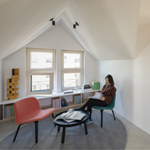
Researchers at the Harvard Center for Green Buildings and Cities (CGBC) share insights from their work
Inside the walls of CGBC headquarters HouseZero™, a team of researchers are conducting a number of experiments related to improved building design and sustainability. The core research team, made up of postdoctoral fellows, research associates, and DDes and PhD candidates from the Harvard Graduate School of Design, strives to produce research outcomes that inform implementations for the building sector.
As research reaches new milestones, CGBC team members reflect on the lessons they have learned throughout their time at HouseZero, sharing professional and personal takeaways.
The science
Xiaoshi Wang, MDes, a PhD candidate in Architecture at the Harvard University Graduate School of Design (GSD), focuses most of his work on the evaluation and modeling of indoor natural ventilation. Though his earlier research utilizes computational fluid dynamics (CFD), Wang’s dissertation is introducing new insights about air flow patterns.
“Part of my work is making a CFD-generated indoor flow pattern as close to real-time as possible. At the same time, for a different study, I’m using machine learning models to predict multi-zone indoor air flow patterns,” Wang said. “Not much literature exists in this area, which has allowed me to design an entire framework and workflow for how to perform such a data-driven prediction pipeline.”
“Before joining the Center, my interest in green buildings was focused on the design and construction phases. I thought utilizing high-performance materials and applying new construction methods were the key features of low-energy and low-emission buildings,” said Sunghwan Lim, MDes, a PhD student in Architecture at the GSD. “My work at the Center has completely shifted this perspective. Through involvement in operation data analysis and control algorithm development, I now know how important it is to have a control system that can synchronize with the building and surrounding environments.”
The collaborations
For Saurabh Mhatre, MDes, Senior Research Associate in the Material Processes and Systems Group (MaP+S) and the CGBC, the most important takeaways from the Center have been the opportunities for interdisciplinary collaboration and academia-industry partnerships.
“The challenges of our time demand rigorous and socially robust knowledge of different domains. There is great novelty in the solutions and opportunities that arise when architects, designers, engineers, material scientists, doctors, and people from various fields collaborate towards a common goal,” said Mhatre, who is not the only researcher to note the value in working together.
“I have learned the most through the Center’s collaborative learning environment. We work together, group ourselves together, and publish papers together,” said Ellie Jungmin Han, DDes, CGBC Fellow. “And, of course, we are connected to the Graduate School of Design (GSD), which has given me another chance to collaborate with faculty, to teach, and to take advantage of resources.”
The professional takeaways
While collaborating with each other, researchers at the CGBC have also learned skills and thought processes necessary to conduct effective research.
“I definitely have a different mindset now for thinking about and approaching research problems,” said Elence Xinzhu Chen, MDes, a doctoral candidate at the Harvard GSD. “When I am approaching a research question, I now think of the scalability, feasibility, and applicability of my methods. I didn’t think in this way prior to my work at the Center.”
Xu Han, PhD, Postdoctoral Fellow at the CGBC, learned that it is important to have a comprehensive, systematic understanding of a concept before asking questions about it in a research project.
“When I first wanted to apply a machine learning algorithm to buildings, I hadn’t taken any courses in machine learning. I tried to learn models as needed, but I didn’t have the fundamental knowledge that was necessary to conduct effective research,” said Han. “Once I fully learned the concepts, I started to see success in my research.”
“In the initial phase of a research project, it is best to spend more time on gaining a profound understanding of the ‘problem’ at hand, and accordingly, why certain research tasks would be necessary rather than focusing on how to perform those tasks. More planning at the beginning stages will always pay off in the end,” said Shide Salimi, PhD, Research Associate at the CGBC. “Having a fundamental understanding of the problem at hand, and collaborating with others, facilitates greater research and results in better outcomes.”
Learn more about the research conducted at the Harvard Center for Green Buildings and Cities.
